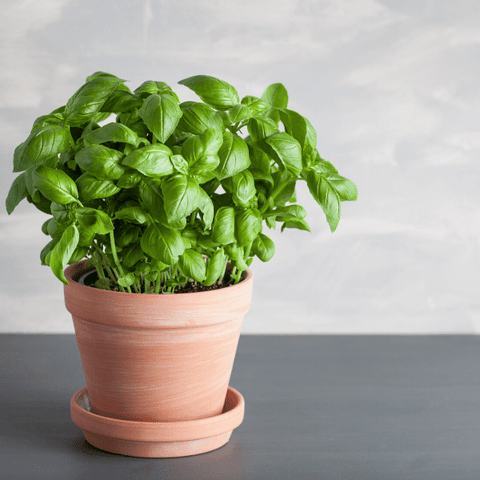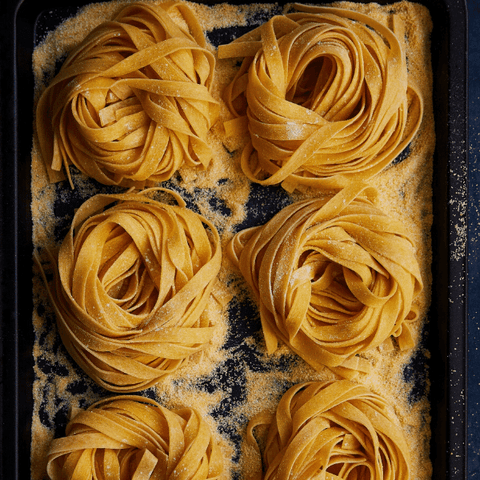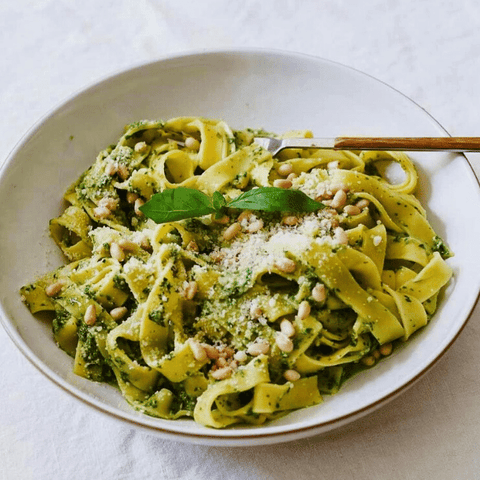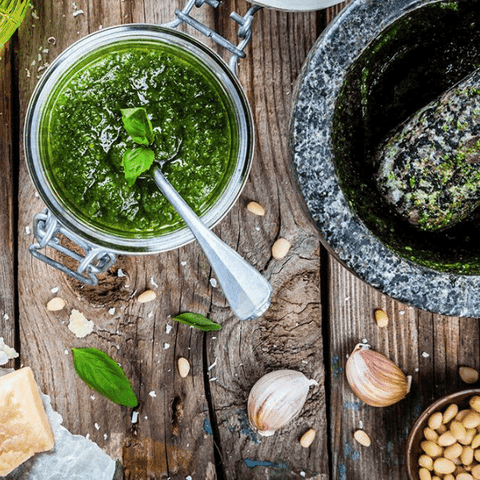Pesto alla Genovese Recipe - Pasta Evangelists
: invalid url input)
The word ‘pesto’ earns its moniker from the Genoese word ‘pestâ’, which means ‘to pound’ or ‘crush’. Traditionally, all of the ingredients for pesto were ground in a marble mortar, so, strictly speaking, pesto can refer to any sauce made by grinding together ingredients. Along with the famed pomodoro (tomato sauce), pesto alla Genovese is likely one of the best-known and most cherished pasta sauces in the world. Though this Genoa-style pesto recipe is fairly youthful in contrast to more historically-established sauces, (with written records dating to approximately 1860), this punchy, aromatic sauce boasts roots dating as far back as the 16th century.
What is pesto alla Genovese?
Pesto alla Genovese is the quintessential pesto recipe. The key to making an excellent pesto all Genovese is using true Parmigiano Reggiano cheese, high-quality olive oil – we use Italian extra virgin olive oil – and fresh basil. In selecting basil, try to get bunches with smaller leaves as these tend to be fresher and more tender. As basil pesto is a dish of few ingredients, the flavour and freshness of its components will greatly impact the final product. For our pesto alla Genovese, we honour tradition, using sweet and subtle pine nuts, as they ensure a distinct creaminess within the bright pesto. However, we encourage experimentation with other nuts, as each variety lends their own unique flavour to the final dish.

Our Pesto alla Genovese does warrant a bit of elbow grease - as admitted traditionalists, we recommend grinding all the ingredients in a pestle & mortar until combined, so your pesto has a slightly coarse consistency. You can, of course, cheat with a food processor, but remain vigilant as to the consistency of your pesto, as it is easy to over-blend your mixture. We believe pesto is best with a slightly rustic texture, rather than a smooth paste.
Which pasta to pair with our pesto alla Genovese recipe

We typically enjoy our fragrant pesto alla Genovese with either trofie or tagliatelle. The former is a shape of pasta rarely found outside its home region of Liguria - a hidden gem, of sorts. Trofie are a proud member of the pasta bianca (white pasta) family – meaning they are made with just water and flour. To form trofie, small pieces of white pasta dough are rolled along the palm of the hand, resulting in sweet, rustic curls with a tapered ends and thicker middle section. The grooves created in this process ensure trofie is a perfect companion to pesto alla Genovese, as they deftly capture the flavoursome sauce.

Tagliatelle, on the other hand, is an egg pasta which hails from the Emilia-Romagna region in the north of Italy. These long-winding golden ribbons capture pesto and meat sauces with ease, due to their increased surface area. Though either type of pasta will pair wonderfully with the rustic texture and bright flavour of your freshly made pesto, the sauce also proves a perfect companion to other dishes - think bite-sized crostini, fresh and creamy mozzarella and vibrant Datterini tomatoes. We can feel the soft Genovese sun on our faces as we speak!

And be sure to take a look at our video on making basil pesto. You can follow along as our chef Roberta whips up her own batch of this delicious pesto.
Pesto alla Genovese recipe
Serves 4
Prep Time: 30 minutes
Cooking Time: 10 minutes
Calories per serving: 250 kcal per serving (excludes pasta)
Ingredients
- 4 cups basil, cleaned and chopped
- 2-3 tbsp extra virgin olive oil
- ½ cup Parmigiano Reggiano, grated
- ¼ cup pine nuts
- 1 clove garlic, minced
- Salt to taste
Tools
- Pestle and mortar
Chef’s tip: If you don’t have a pestle and mortar at home, you can use a food processor. We like a pesto that has a slightly rustic texture so be sure not to over grind.
Method
- Start by gently toasting the pine nuts in a dry frying pan over medium-high heat until they turn slightly brown in colour and are fragrant. Keep them moving to prevent burning. In the case that any get dark brown, be sure to remove them before adding to the basil as they will impart a burnt flavour to the pesto.
- Put the basil, grated Parmigiano Reggiano, minced garlic clove and 2 tablespoons of the extra virgin olive oil to a pestle and mortar and grind until creamy
- Add the pine nuts and grind until they start to break down and combine with the oil and basil mixture. You should have a creamy yet slightly chunky consistency.
- Drizzle the remaining olive oil and continue to grind until you have a creamy paste. We recommend leaving it a little rustic as this will help it adhere to the pasta
- The pesto is best eaten straight away, but can be kept in clean mason jars and stored in the refrigerator for up to a week.

How to serve your pesto alla Genovese
When preparing to serve your pasta, mix 2-3 tablespoons of reserved pasta water into the pesto. The starch and salt in the pasta water lends flavour, but will also help loosen a pesto coming directly from the fridge. Next, simply toss the al dente pasta of choice with the pesto. Top with a generous helping of freshly grated Parmigiano Reggiano and you're ready to enjoy your pasta with pesto alla Genovese!
Share your creations with us, tagging #pastaevangelists on Instagram.
At Pasta Evangelists, we bring a taste of Italy to your kitchen. Prepared using the freshest ingredients, our gourmet pasta dishes are perfect for those looking to enjoy restaurant-quality meals, delivered to your door, and ready in under five minutes. Order from our weekly menu today, and we’ll offer you 25% off your first delivery - simply enter the code BLOG25 at checkout.







